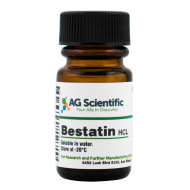The need for improved tools within the proteomic field is an ongoing, rapidly evolving endeavour. Today, I detail a novel approach utilizing a chemical biology strategy denoted as activity-based probes (ABPs). The aim is to functionally profile enzyme classes in their activity state. In the following example, metallo-aminopeptidases was profiled based upon synthesizing the bestatin inhibitor scaffold. It is the first synthesis of bestatin analogues using solid-phase techniques.
The need for improved tools within the proteomic field is an ongoing, rapidly evolving endeavour. Today, I detail a novel approach utilizing a chemical biology strategy denoted as activity-based probes (ABPs). The aim is to functionally profile enzyme classes in their activity state. In the following example, metallo-aminopeptidases was profiled based upon synthesizing the bestatin inhibitor scaffold. It is the first synthesis of bestatin analogues using solid-phase techniques.[Get your Free Bestatin Brochure here.]
 Peptidases are a promising class of anti-malarial drug targets that perform several important roles during the Plasmodium falciparum erythrocytic life cycle. This is especially important given the emergence of drug resistance in Plasmodium falciparum, the causative agent of most malaria-associated deaths.
ABPP is a biochemical, and peptidomic strategy that utilizes mechanism-based, tagged small molecule inhibitors to discover new enzymes, profile their activity state in complex proteomes, and identify potential functions for these enzymes during a specific biological process.
Peptidases are a promising class of anti-malarial drug targets that perform several important roles during the Plasmodium falciparum erythrocytic life cycle. This is especially important given the emergence of drug resistance in Plasmodium falciparum, the causative agent of most malaria-associated deaths.
ABPP is a biochemical, and peptidomic strategy that utilizes mechanism-based, tagged small molecule inhibitors to discover new enzymes, profile their activity state in complex proteomes, and identify potential functions for these enzymes during a specific biological process.
 Through the synthesis of a suite of activity-based probes (ABPs) based on the general MAP inhibitor scaffold, bestatin, we generated specific ABPs for these two enzymes, metallo-aminopeptidases (MAPs), PfA-M1 and Pf-LAP.
Replacement of a bulky reporter tag with an alkyne group resulted in smaller, more versatile ABPs that allowed for their use in live cells for phenotypic analysis along with more tradition lysate-based ABPP is reported.
Through diversification of the bestatin scaffold, scientists were able to create a suite of ABPs with increasing specificity for both PfA-M1 and Pf-LAP and used these ABPs to further understand the functions of these essential enzymes
The collective data suggest that these two MAPs are both potential antiparasitic drug targets. In fact, PNAP is, to published knowledge, is the most potent parasite MAP inhibitor with an IC50 in the 200 nM range, which gives us hope that these types of inhibitors could be further developed into more drug-like therapeutics.
References:
Through the synthesis of a suite of activity-based probes (ABPs) based on the general MAP inhibitor scaffold, bestatin, we generated specific ABPs for these two enzymes, metallo-aminopeptidases (MAPs), PfA-M1 and Pf-LAP.
Replacement of a bulky reporter tag with an alkyne group resulted in smaller, more versatile ABPs that allowed for their use in live cells for phenotypic analysis along with more tradition lysate-based ABPP is reported.
Through diversification of the bestatin scaffold, scientists were able to create a suite of ABPs with increasing specificity for both PfA-M1 and Pf-LAP and used these ABPs to further understand the functions of these essential enzymes
The collective data suggest that these two MAPs are both potential antiparasitic drug targets. In fact, PNAP is, to published knowledge, is the most potent parasite MAP inhibitor with an IC50 in the 200 nM range, which gives us hope that these types of inhibitors could be further developed into more drug-like therapeutics.
References:
- Development of bestatin-based activity-based probes for metallo-aminopeptidases. MB Harbut et al, Bioorg Med Chem Lett, November 15, 2008; 18(22): 5932-6.
- Bestatin-based chemical biology strategy reveals distinct roles for malaria M1- and M17-family aminopeptidases, Michael B. Harbut et al, PNAS August 23, 2011 vol. 108 no. 34 E526-E534.

